
The global authority in superyachting
- NEWSLETTERS
- Yachts Home
- The Superyacht Directory
- Yacht Reports
- Brokerage News
- The largest yachts in the world
- The Register
- Yacht Advice
- Yacht Design
- 12m to 24m yachts
- Monaco Yacht Show
- Builder Directory
- Designer Directory
- Interior Design Directory
- Naval Architect Directory
- Yachts for sale home
- Motor yachts
- Sailing yachts
- Explorer yachts
- Classic yachts
- Sale Broker Directory
- Charter Home
- Yachts for Charter
- Charter Destinations
- Charter Broker Directory
- Destinations Home
- Mediterranean
- South Pacific
- Rest of the World
- Boat Life Home
- Owners' Experiences
- Interiors Suppliers
- Owners' Club
- Captains' Club
- BOAT Showcase
- Boat Presents
- Events Home
- World Superyacht Awards
- Superyacht Design Festival
- Design and Innovation Awards
- Young Designer of the Year Award
- Artistry and Craft Awards
- Explorer Yachts Summit
- Ocean Talks
- The Ocean Awards
- BOAT Connect
- Between the bays
- Golf Invitational
- Boat Pro Home
- Pricing Plan
- Superyacht Insight
- Product Features
- Premium Content
- Testimonials
- Global Order Book
- Tenders & Equipment


Pearl 62: On board Pearl Yachts' latest superyacht
With competitors backed by powerful international conglomerates, the only way for family-run builders to survive is to do things better – or differently. Andrew Johansson says Pearl Yachts’ latest model, the Pearl 62, promises both...
As I approach the 18.6-metre Pearl 62, moored in Southampton on a wet and gusty day, it is clear that she is an attempt to revive the essence of the British brand’s obsolete Pearl 60 and 65. The exterior styling, by Dixon Yacht Design , embraces the visual DNA of these older models while offering modern appeal with larger windows and longer, uninterrupted stretches of glass. Crucially, these stylistic advances retain the signature look of a Pearl yacht.
“There are clear and simple lines on the profile that we wanted to carry over from one boat to the other,” explains Bill Dixon, founder of Dixon Yacht Design, who has a long-standing relationship with the British shipyard. “While you style the outside, you need to ensure it will work on the inside too. The secret to this boat was creating it as a whole and then making sure each space worked with the other.”
In a marketplace offering a healthy variety of options, relying on the tried-and-tested simply won’t cut it: maintaining client interest is harder than ever. This fact is all too evident to Pearl Yachts’ managing director Iain Smallridge, who wanted to combine new ideas with the successes of the past to meet today’s client demands. The goal was to deliver a product that offers more than its competitors and execute it to a standard expected of much larger boats.
“We wanted to replicate the success we had with the Pearl 60, which was an aft cabin design, on the Pearl 62,” says Smallridge. “The USP of the Pearl 60 was that it had four cabins. We sold about 30 boats over a period of eight or nine years, making it the most successful model we’ve had to date. So, with the Pearl 62 we have a full-beam owner’s suite with dedicated staircase amidships, along with a double and two twin suites up forward and the option of a crew cabin or jet ski garage aft, which is unique in the market.”
With the exterior taking a back seat to the requirements of the layout, a generous internal space has been achieved with decorative schemes to suit most tastes – the yard offers two options on the 62. Stepping through the floor-to-ceiling sliding doors and into the main saloon, the quality is immediately evident on this modern interior edition. The light colour palette with dark accents, together with materials such as wood and marble, have been used throughout.
The interior design’s attention to detail is worthy of a superyacht. The wooden frame that bridges the main saloon to the galley on the main deck, for example, has been constructed from individually cut wooden pieces sandwiched together – rather than routing one piece of wood – to create an engaging vertical ribbed effect.
With the exterior taking a back seat to the requirements of the layout, a generous internal space has been achieved with decorative schemes to suit most tastes – the yard offers two options on the 62. Stepping through the floor-to-ceiling sliding doors and into the main saloon, the quality is immediately evident on this Modern interior edition. The light colour palette with dark accents, together with materials such as wood and marble, have been used throughout.
This detail is replicated on doors, panelling and furniture throughout the yacht. The wooden frame’s slats also act as a visual break between the two internal zones of the boat without obstructing the valuable views fore and aft.
“The joinery detailing is very organic and sculptural, using a blonde wood mixed with black and neutrals,” says Kelly Hoppen, founder of Kelly Hoppen Interiors and the Pearl 62’s interior designer. “For me, the change of textures and colour was the difference [on this project], as well as the sculptural moulded joinery, which I adore. I also love the ribbed effect throughout the yacht, enhancing the layering of textures and lighting details, which are always so important on a yacht.”
The main saloon, guest cabins and owner’s suite feel larger than they actually are thanks to the carefully planned layout and head height that rises and dips with the floor level. Multiple windows and a spacious staircase forward lead the eye ahead to the double guest suite in the bow on the lower deck. Access to this cabin is via a spacious lobby from which two twin suites are accessed. Above the double cabin is a sunpad and forward-facing seating with a foldaway teak table, while the aft deck hosts al fresco dining. The flybridge includes additional seating and sun loungers, a wet bar and cool box with shade provided by an optional hardtop with retractable sunroof.
“When we developed the Pearl 75 in 2014 we wanted a different angle on the interior design. All the production boat builders tend to produce variations of the same theme and we all followed a predictable pattern,” says Smallridge as he explains why Pearl Yachts commissioned Hoppen for the 62.
“When we began with the Pearl 75, we wanted something that was stylish and designer but wasn’t a variation of someone else’s theme. So when I was introduced to Kelly’s work, I really liked her style, the quality of the design and its exclusivity. I think anyone who looks at our yachts styled by Kelly Hoppen will quickly understand why we went down that road.”
This partnership certainly offers something different from the market, but the special appeal of this boat is really the space on offer. By adopting the qualities of the Pearl 60 combined with a fresh new look outside and in, and by pushing the engines as far aft as possible with the use of Volvo IPS drives, Pearl has made this yacht bigger than would otherwise have been possible. In particular, the space saving nature of the pods allows for a jet ski garage or crew cabin above them. While the engine room is fitted with one of three twin engine options, at the time of writing most clients have specified the most powerful IPS 1200s.
In short, the Pearl 62 delivers what the market wants – a spacious, well-executed and finished yacht that is simple for owners to navigate. The limited production of these boats over its competitors also adds an element of exclusivity. The quality and space that comes with the 18.6-metre is evident as soon as you step on board, and with nine boats already sold and interest continuing to grow, the Pearl 62 is on course to beat its much-loved predecessors in every sense.
More stories
Most recent, from our partners, sponsored listings.
DESIGN YOUR OWN PEARL 62
You don’t merely purchase a Pearl, you commission a yacht that is yours and yours alone.
BOOT D Ü SSELDORF 2023
COME AND VISIT US! 21st – 29th January 2023 Hall 06/A22
Register your interest for a one-to-one talk and a visit on board the new Pearl 72 (european debut).
THE ATELIER OF YACHTING
To produce a limited number of high-quality yachts each year is a brand-defining choice. We are driven to offer a premium product, designed by the world’s most renowned yacht and interior designers, meticulously engineered, and crafted by expert hands, obsessed with perfecting every detail. Pearl builds yachts in an oyster, a state-of-the-art production facility that houses the entire supply chain. Only in this way can we keep faith with our mission: to offer you a yachting experience as unique and prized as the rarest of pearls. Boutique Yacht Builder since 1998.
To produce a limited number of high-quality yachts each year is a brand-defining choice. We are driven to offer a premium product, designed by the world’s most renowned yacht and interior designers, meticulously engineered, and crafted by expert hands, obsessed with perfecting every detail. Pearl builds yachts in an oyster, a state-of-the-art production facility that houses the entire supply chain. Only in this way can we keep faith with our mission: to offer you a yachting experience as unique and prized as the rarest of pearls.
Boutique Yacht Builder since 1998.
A PERSONAL AFFAIR
Pearl’s thoughtful design and world-class craftsmanship is evident from the beautifully streamlined exterior to the stunningly appointed, ingeniously spacious interiors. Owners are offered a selection of engines and layouts, and can tailor the interior with their choice of the Kelly Hoppen CBE designed interior themes: Modern, Luxury and Indulgence. Above all, the shipyard always guarantees a level of personal attention beyond comparison, working closely with each owner to ensure that every detail is just right.
Pearl’s thoughtful design and world-class craftsmanship is evident from the beautifully streamlined exterior to the stunningly appointed, ingeniously spacious interiors. Owners are offered a selection of engines and layouts, and can tailor the interior with their choice of the Kelly Hoppen CBE designed interior themes. Above all, the shipyard always guarantees a level of personal attention beyond comparison, working closely with each owner to ensure that every detail is just right.
DESIGNING EXPERIENCE
Attention to detail is the pride of our design team. Headed up by award-winning naval architect Bill Dixon, Pearl’s design ethos of beautifully crafted yachts, leading innovation and superb sea-keeping is evident in both the aesthetics and functionality, with key pioneering steps in the most exciting new directions being made across the whole range of yachts. Adding an extra cabin where no other brand could, integrating next-generation propulsion systems ahead of the rest, and drawing striking, recognizable lines for the exterior are just a few examples of how Bill Dixon has brought Pearl Yachts into competition with the industry frontrunners.

DESIGNING THE EXPERIENCE
Discover beauty within.
No other yacht company works with the world-renowned British designer Kelly Hoppen CBE. Her ever-evolving style, defined by a subtle fusion of clean lines and neutral tones, intuitively balanced with an opulent warmth, has been honoured with numerous prestigious awards. Every Pearl is a canvas, upon which Kelly’s unmistakable design philosophy takes shape into a unique and surprising yet coordinated interior. For owners, this means the very thing one buys a yacht to secure: to feel in place wherever one goes, to find one’s intuitions reflected in the environment and to keep the mind sharp without feeling on edge. In other words, Kelly has a knack for putting things together as they should be.

BEYOND CUSTOMER CARE
Care. It might be a small word, but it means a lot to us at Pearl. Nobody cares more about your experience than we do. We offer a round-the-clock aftersale service to ensure that you’re happy with every part of your life as a Pearl owner. In addition, each new yacht benefits from an industry-leading comprehensive 5-Year warranty, designed to safeguard your investment, protect her residual value and give you absolute peace of mind long into the future. Whatever you need to make the most of your Pearl experience, we’ll always be on hand to advise and inspire wherever you and your yacht may reside.

- DEALER AREA
Privacy Overview

New Yacht For Sale: Pearl 62
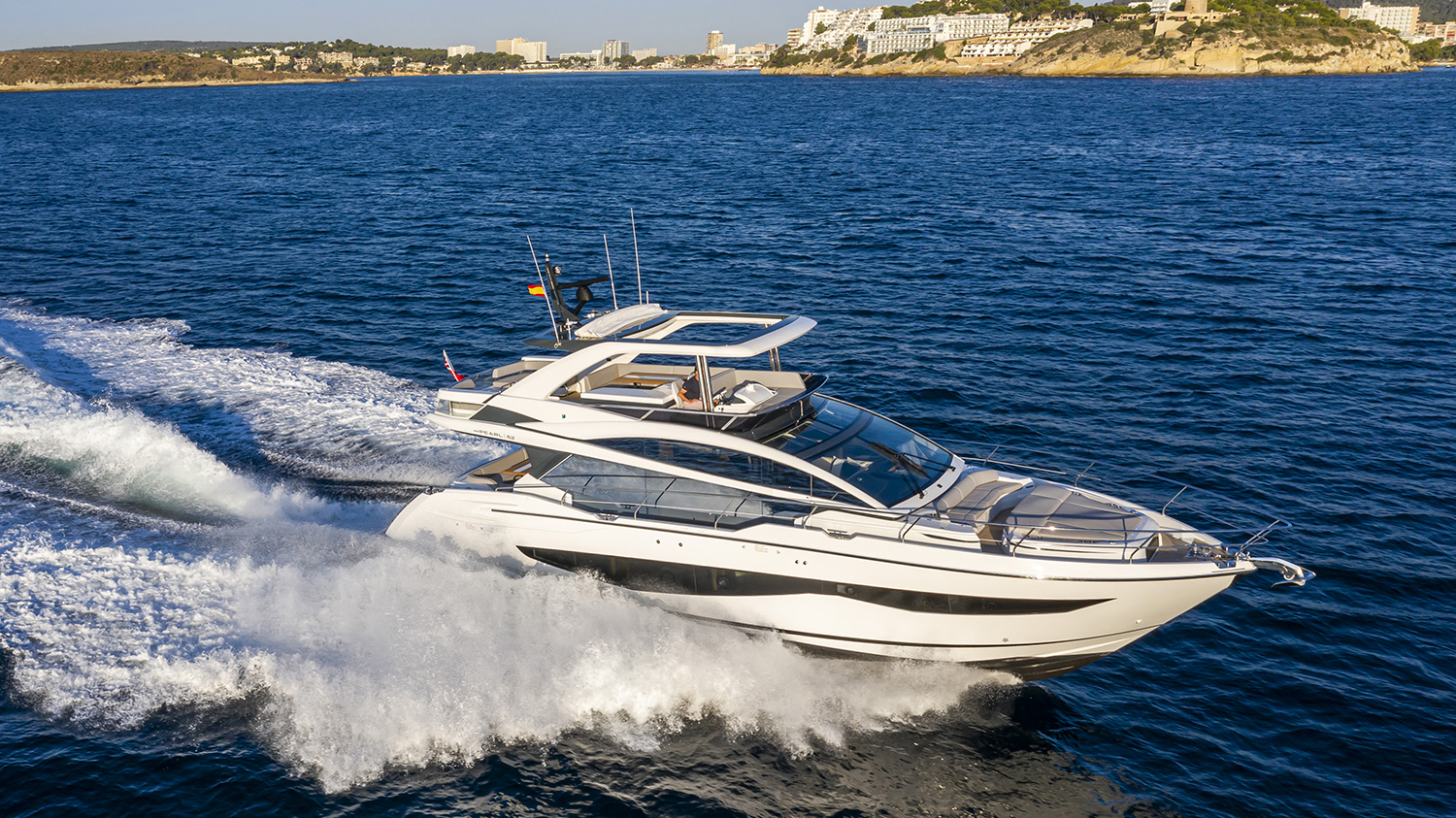
Pearl Yachts latest new model boasts even more contemporary design, cutting edge technology, enhanced performance and versatility. The new Pearl 62 has been once again created by the successful collaboration between award-winning naval architect Bill Dixon and world-renowned interior designer Kelly Hoppen, MBE.
- 4 x double guest cabins
- Crew cabin or Jet ski garage
- IPS pod drive with joy stick control and station keeping
- Full beam mid-ship master cabin with separate entrance
- Foredeck lounge
- Aft galley open to the cockpit
- Dixon Yacht Design exterior styling and naval architecture
- Kelly Hoppen interior design with choice of styles
- 5 year warranty
- Optional Seakeeper stabiliser
- Optional hard top with sunroof
- Optional hi-lo hydraulic bathing platform
- Optional side door
Looking For A Pearl?
2022 pearl 62'.
Motor Yachts
2024 Pearl 62'
- THE PRINCESS PASSPORT
- Email Newsletter
- Yacht Walkthroughs
- Destinations
- Electronics
- Best Marine Electronics & Technology
- Boating Safety

For Sale: Pearl Yachts 62
- By Donny Gilbert
- February 16, 2024
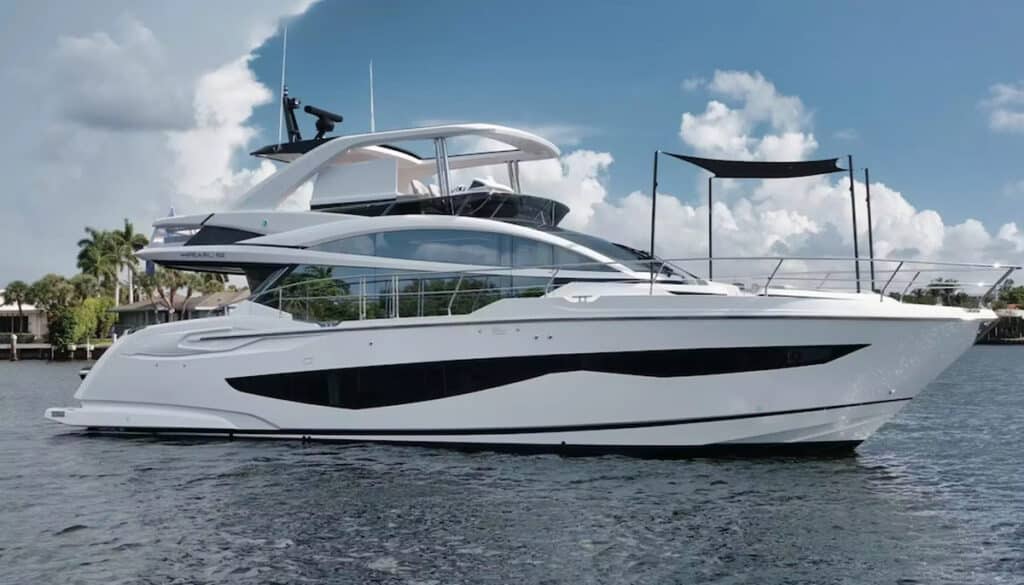
Display , a Pearl Yachts 62, is currently listed with Atlantic Yacht and Ship for $3.35 million. This family-friendly, 2022 flybridge motor yacht features four staterooms and plenty of deck space for entertaining.
The Pearl 62 was first introduced in 2020 , replacing the 65 as the entry-level model in Pearl’s portfolio.
“Like previous Pearls, the 62’s profile is sporty for a design that packs full-size utility, which means a flybridge, cockpit, full side decks and a foredeck terrace,” Yachting previously reported . “Lots of natural light adds to the sense of space inside; beyond all the glazing in the superstructure, there are aft-deck doors, hullside windows, a two-pane windshield, and sunroofs between the top of the windshield and the flybridge.”
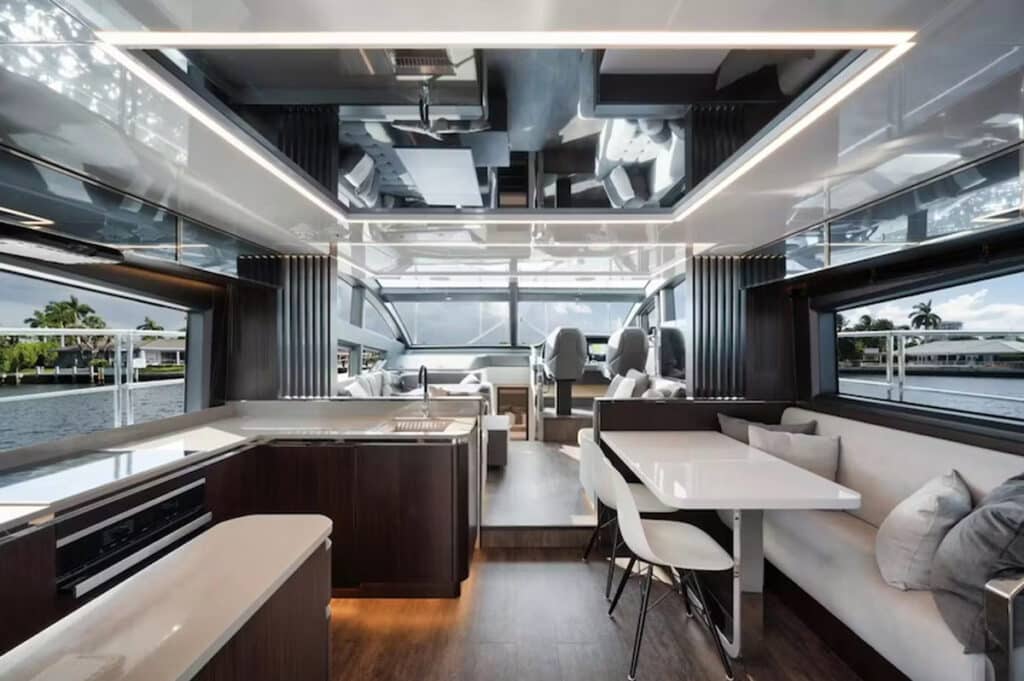
It is outfitted with twin 900 hp Volvo Penta IPS1200s and reaches around 32 knots.
The four staterooms include a separate access, full-beam owners’ stateroom with an en suite, a VIP forward and twin guest staterooms to port and starboard. Guest staterooms also have sliders to convert from twin berths to queen berths for couples.
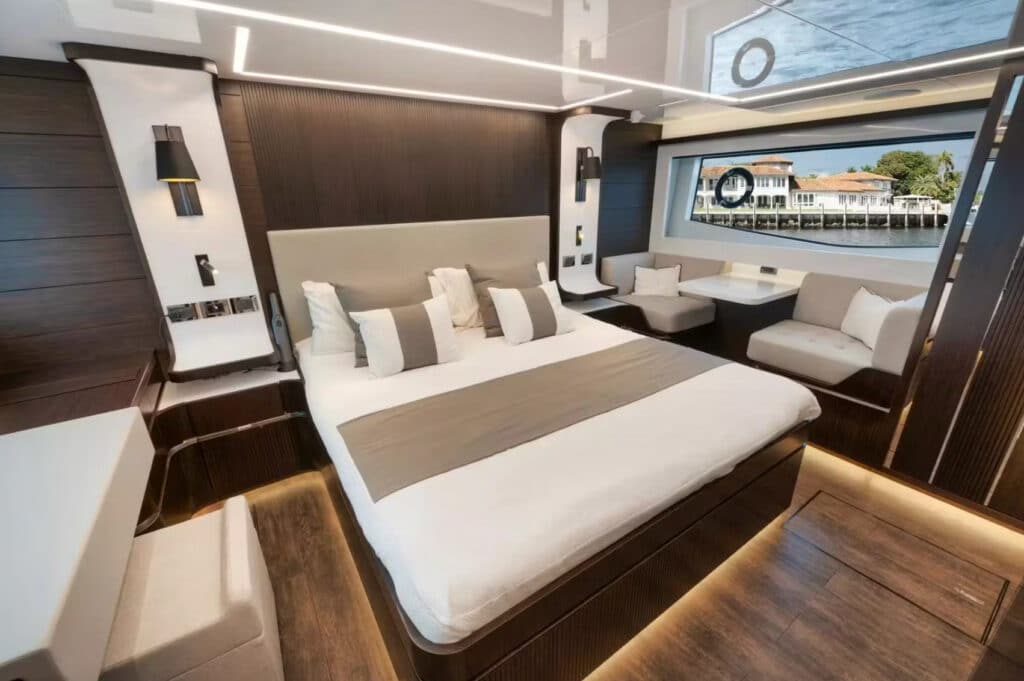
Additionally, Display has an optional en suite cabin for a crewmember.
The flydeck, foredeck and aft deck offer plenty of options for entertaining and dining with the family.
“Pearl Yachts latest new model boasts even more contemporary design, cutting edge technology, enhanced performance and versatility,” according to Atlantic. “The new Pearl 62 has been once again created by the successful collaboration between award-winning naval architect Bill Dixon and world-renowned interior designer Kelly Hoppen.”
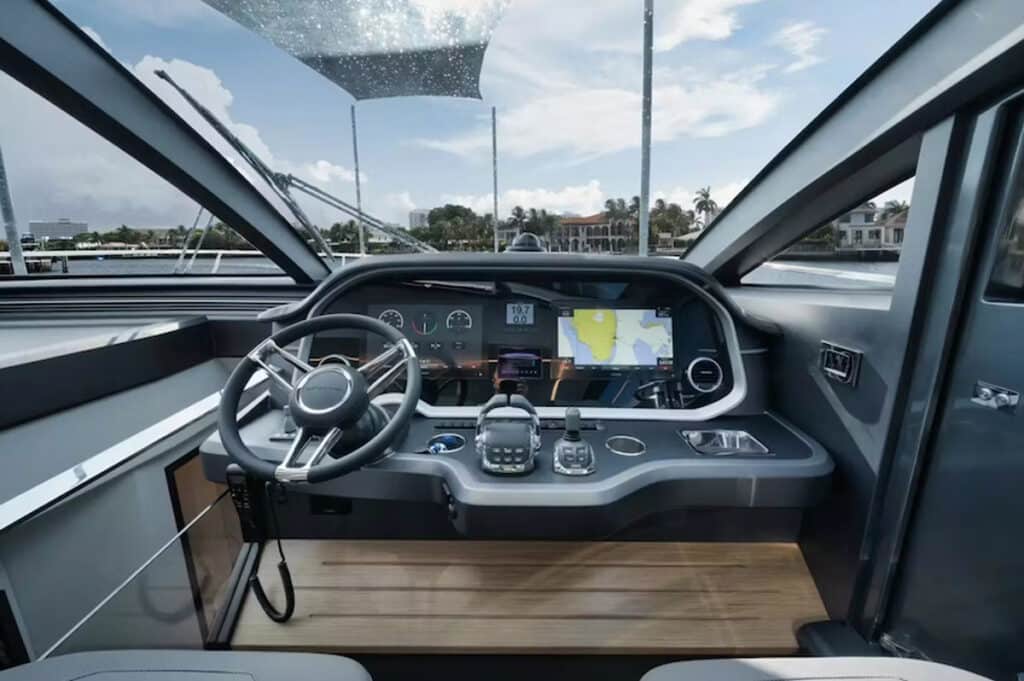
Step up to the flybridge on Display and the first thing you will notice is the hardtop covering the deck with a makefast sunroof, topside canvas and underside mesh. The flybridge is fitted with teak decking, upholstered seats with stowage underneath, a teak table, and a forward sunbathing area with upholstered seats. At the helm, you will find two Besenzoni STEALTH adjustment helm seats and a custom-made acrylic flybridge windscreen. Navigation equipment for Display is listed below:
- Garmin GMI 20 Marine Instrument display
- Garmin Autopilot reactor pack displayed on Garmin helm screens
- Garmin VHF at lower helm
- Garmin VHF Remote handset at upper helm
- Garmin transducer, DST 800, plastic thru-hull (speed, depth, temperature)
- Compass 3 3/4″ dial (upper and lower helm)
- Garmin GMR Fantom 54, 50 W Pedestal * 4-foot antenna
- Volvo Dynamic Positioning System
- Additional 2 x VOLVO 8616 MFD (GARMIN GPSMAP) 1 at lower helm & 1 at upper helm (in total 2 at each helm) – upgrade
- Garmin AIS 800 Kit – upgrade
- Garmin GA 38 GPS/Glonass Antenna for AIS receiver – upgrade
- Seakeeper SK9 gyrostabilizer
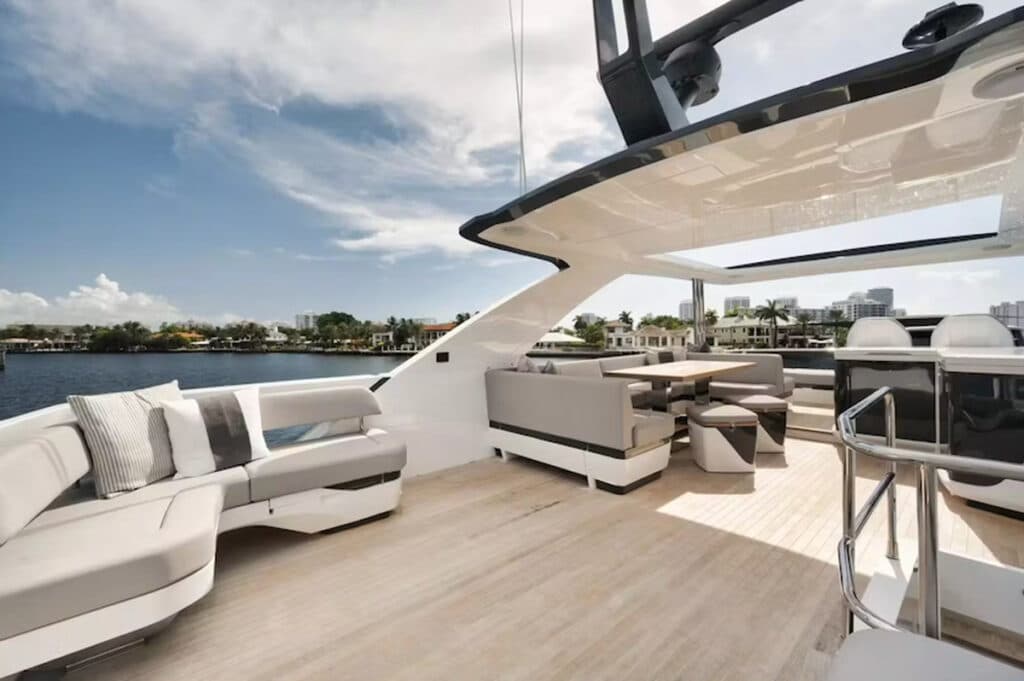
Below the flybridge, the main deck area on Display has a teak in the cockpit and bathing platform. A wet bar is also available on the main deck to help easily entertain friends and family. Display has a stainless-steel pulpit and handrails. On the foredeck, there is a Bedouin style canopy, sunbathing area with upholstered seats, and a teak fold-out table with seating.
Other amenities passengers will enjoy on Display :
- Opacmare hydraulic Passerelle
- H&B technics hydraulic bathing platform laid with teak
- Armstrong telescopic swimming ladder fitted to the bathing platform
- Transom swim shower
- Stainless-steel stern cockpit gate with Pearl logo
- Cockpit seating
- Cockpit teak table
- Marine stainless-steel folding patio door with electrically operated window to the side
- Pantograph side door from lower helm
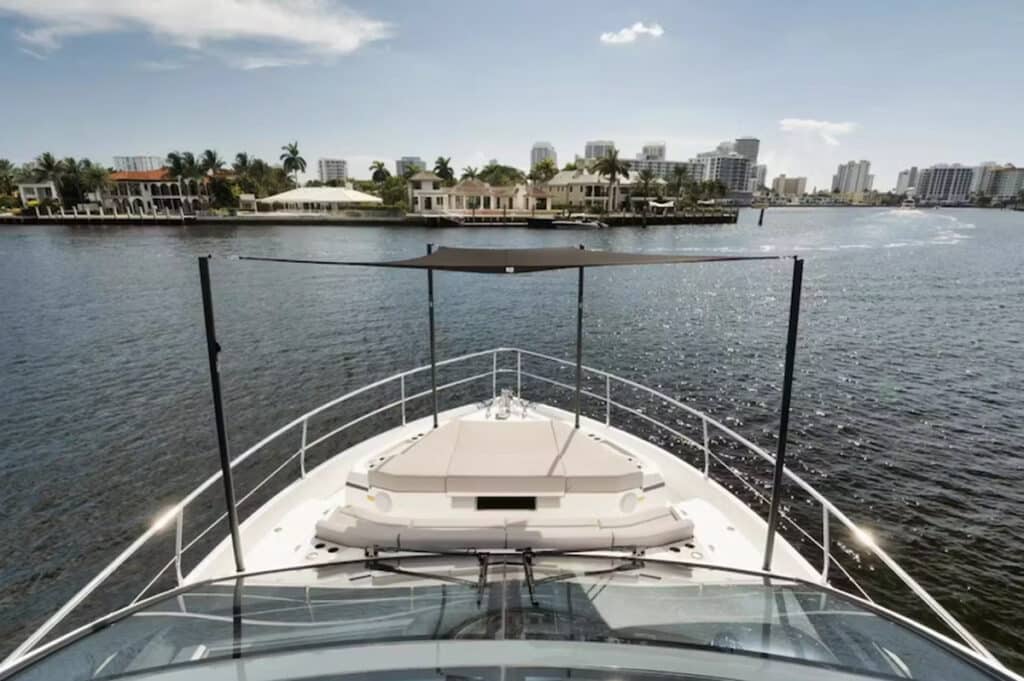
Where is Display located? The yacht is currently lying in Dania Beach, Florida.
Take the next step: contact the listing agent, Chris Carroll, (945) 921-1500, atlanticyachtandship.com .
Quick Specifications
- Length Overall: 62′
- Maximum Beam: 17’5″
- Fuel Capacity: 726 Gal.
- More: 50'-99' , Atlantic Yacht and Ship , Brokerage , Pearl Yachts , Yachts for Sale
- More Brokerage
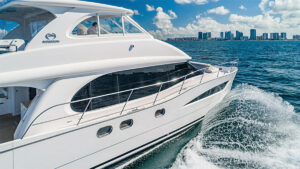
For Sale: Horizon Power Catamarans 52
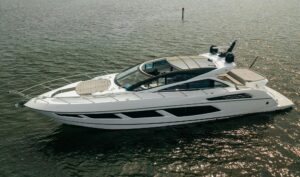
For Sale: Sunseeker Predator 68
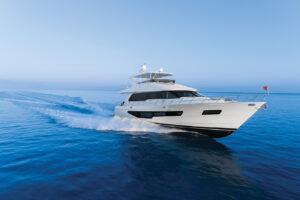
For Sale: CL Yachts CLB 72
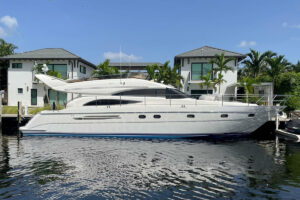
10 Yachts Under $500,000 You Can Have Today
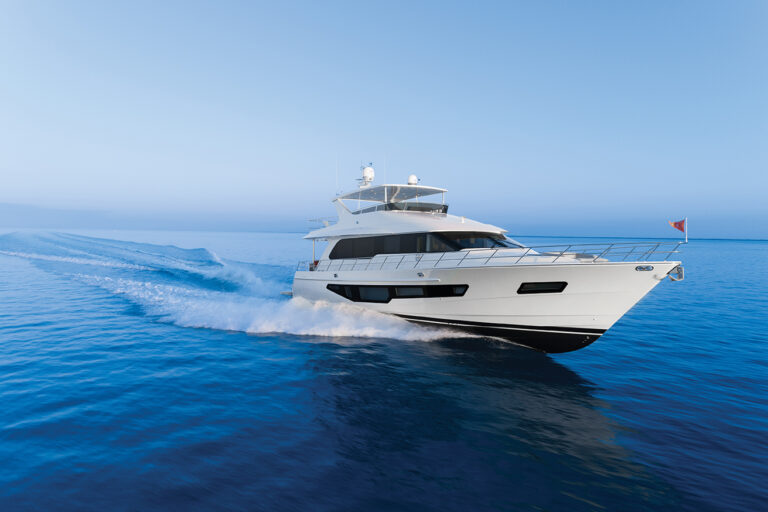
How to Swing a Compass on a Boat
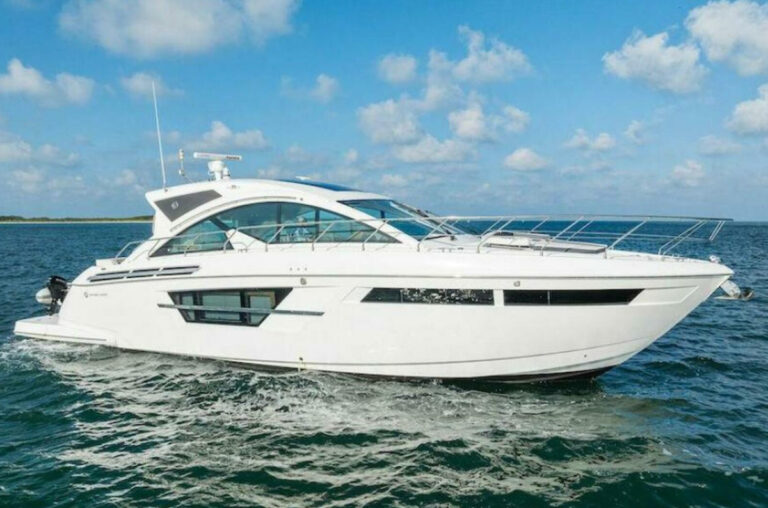
For Sale: 2019 Cruiser Yachts 54 Cantius

- Digital Edition
- Customer Service
- Privacy Policy
- Email Newsletters
- Cruising World
- Sailing World
- Salt Water Sportsman
- Sport Fishing
- Wakeboarding
- Pardo Yachts
- Sirena Yachts
- Pearl Yachts
- Yacht Management
- San Diego Main Office
- San Diego Marina
- Newport Harbor
- Wrightsville Beach

Pearl Yachts latest new model boasts even more contemporary design, cutting edge technology, enhanced performance and versatility. The new Pearl 62 has been once again created by the successful collaboration between award-winning naval architect Bill Dixon and world-renowned interior designer Kelly Hoppen, MBE. The 62 packs a full complement of utility in its sporty profile.

Technical Data
Draft: 10.67, virtual tour.
Above, the flybridge includes a full helm station and sun seat, settee and table, lounge area, and wet bar. On the main deck, a sense of space in the cockpit and main salon is enhanced by natural light streaming though large lateral windows, aft-deck doors, and sunroofs between the windshield and flybridge. The fully functioning galley opens to an optional dinette, and transitions to a spacious aft lounge area. As you descend to a large swim platform, transom arrangements include a garage and crew cabin. Below decks, you’ll find a four-stateroom, three-head layout, that includes spacious and generously appointed Master and VIP suites, and 2 double berth guest cabins. You’ll have a selection of Kelly Hoppen soft, calm, cool and soothing interior themes, along with a host of advance navigation, system controls, and entertainment combinations to choose from. With a choice of IPS Volvo engines ranging from 950HP to 1200HP, and a fuel capacity of 821 gallons, you can enjoy an estimated range at cruising speed of up 250NM.

Available Inventory

2023 Pearl 62
Newport Beach, CA

- Advertising

Heritage Special: The Il-62, Russia’s First Long Haul Jetliner
The history of the Ilyushin Il-62
The Soviet Union had a jetliner (the Tu-104) and a long hauler (the Tu-114 propliner) but it took the Il-62 to be both, bringing the most far-flung corners of the empire, and the world, to Moscow at jet speed.
The story of Russia’s first long haul jetliner begins in the century before last, with the birth of aircraft designer Sergei Vladimirovich Ilyushin on March 30, 1894, in the Vologda Oblast in northeast Russia. After training in the Tsarist Army as a pilot in 1917, and as an aircraft technician in the Red Army after the revolution, his future as one of the world’s most famous aircraft designers was probably set in stone in late 1919 when a British Avro 504 fighter plane crashed near Petrozavodsk — he was one of the team who took the plane apart and transported it to Moscow to be reverse-engineered and built as the Soviet U-1 trainer, of which 707 were built. In 1921 he joined the Red Army Engineering Institute and the Air Force Science and Technical Committee in 1926. In 1931 he began working as an aircraft designer at TsAGI, and in 1933 became chief designer at the TsKB (Ts = Central, KB = Design Bureau) which in 1935 became the Ilyushin OKB.
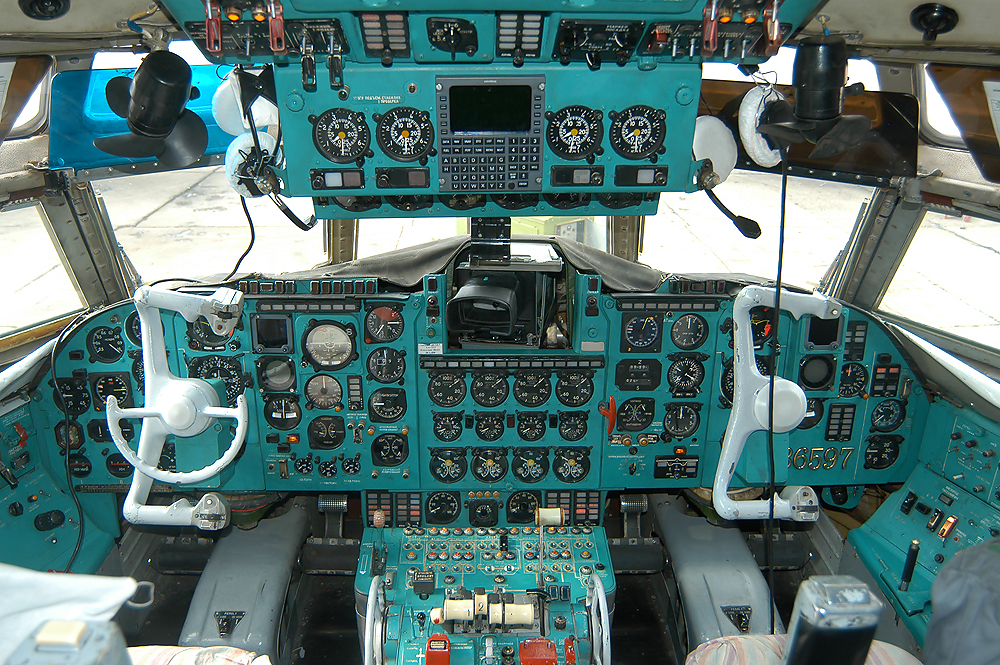
The first production aircraft designed by the Ilyushin OKB was the Il-2 ground attack aircraft which was then the most produced aircraft of all time, with 36,183 built (including the Il-10 development, the number rises to 42,330). After World War 2, the focus turned to civil aviation – between 1950 and 1959, domestic air traffic within the Soviet Union grew tenfold. The Ilyushin OKB was at the forefront, with the first of 2,011 Il-12 and Il-14 propliners flying in 1950, and the four-engined long haul Ilyushin Il-18 turboprop following in 1957.
The Tupolev Tu-104 was doing great work and could stay up for two or three hours at a time, but the Soviet Union needed a true long haul machine, so in February 1960 Sergei Ilyushin himself presented a proposal for a four-engined passenger jet to the Soviet Council Of Ministers, and received a formal go-ahead on June 18. The Kuznetsov OKB, specialising in aeroengines, was simultaneously instructed to develop what would become the NK-8 turbofan engine.
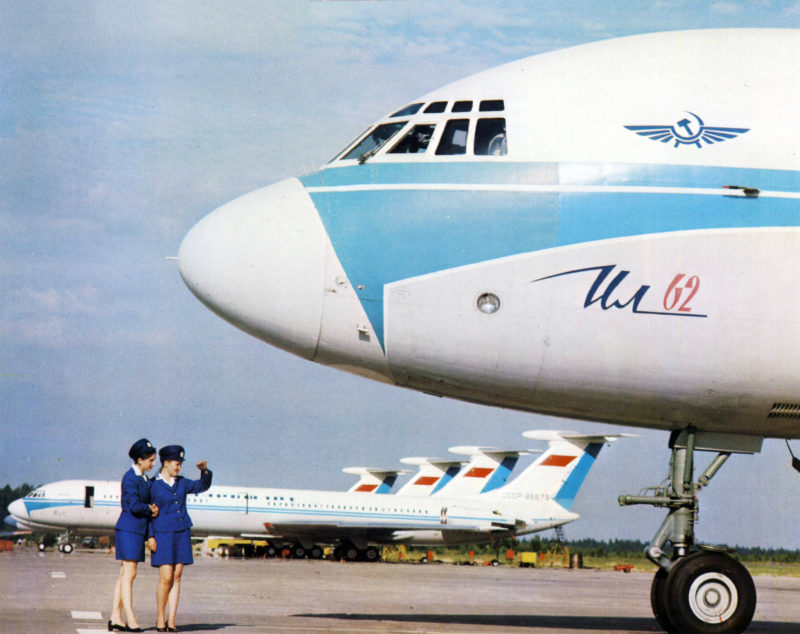
The placement of the engines in pairs on the rear fuselage would later be controversial in the West as it so closely replicated the contemporary Vickers VC-10 produced in Britain. In fact the configuration was dictated by TsAGI on the basis that the Ilyushin OKB did not have the resources to engage in prolonged configuration studies and engine placement on the rear fuselage was considered scientifically correct and thus immutable. (Indeed engines attached to the wing by pylons remained anathema to Soviet airline design until the entry into service of the widebody Ilyushin Il-86 in 1980.)
In fact the layout was also shared with the Lockheed L-329 / L-1329 Jetstar business jet, against which there are no accusations of plagiarism, and has several advantages which are no doubt why it appealed to Vickers and Lockheed as well as Ilyushin — a very quiet passenger cabin, a clean wing optimised for aerodynamic efficiency, and a smaller rudder required due to the lack of asymmetrical power in the event of an engine failure.
Another noteworthy design element on the Il-62 is the distinctive ‘dogtooth’ indentation in the leading edge of the wing, which was added to create a powerful vortex over the wing at low speeds, localising the turbulent airflow of an incipient aerodynamic stall and protecting the high lift outboard wing. The flight controls were also fitted with a ‘stick shaker’ to warn of an approaching aerodynamic stall, and a ‘stick pusher’ which would physically force the control column forward if the aircraft reached a fully-stalled condition. This feature was met by resistance by pilots at the time, but is a feature of all T-tailed aircraft today.
The horizontal stabiliser is small for the size of the aircraft and the consequent aerodynamic load. This reduces cruise drag significantly (and structural weight a bit) at the expense of having the wing placed slighty further forward. This creates no issues in flight but in some loading regimes, can place the centre of gravity aft of the main landing gear, which gave rise to another Il-62 trademark, the retractable tail stand. is extended when the aircraft is parked. With the tail stand in place, loading and unloading can be done in any order without risk of the aircraft tipping up on its tail.
The first prototype, registered CCCP-06156, taxied under its own power at Khodynka airfield in Moscow, on September 19, 1962. The engines used initially were Ljulka AL-7 turbojets as the Kuznetsov NK-8 was still being readied for use. The AL-7 had many successful military applications such as the Sukhoi Su-7 Fitter and Su-9 Fishpot as well as the AS-3 Kangaroo cruise missile and even the Beriev Be-10 flying boat.
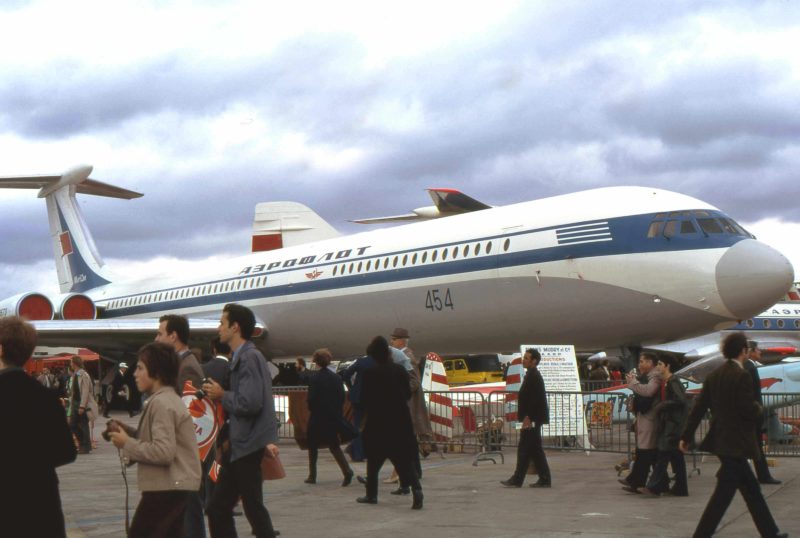
CCCP-06156 was formally unveiled to the country’s top brass including General Secretary Nikita Khrushchev at Khodynka on September 24. After that, the machine was dismantled and transported by road to Zhukovsky, south east of the capital, home of TsAGI and the Soviet Union’s main centre of aerospace research and development, where it was reassembled for flight testing. High speed taxi runs resumed on December 19, and the aircraft even made a few short hops into the air of a few seconds each.
The Il-62’s first flight was a successful thirty-four minute sortie on the morning of January 2, 1963 under the command of Captain Vladimir K. Kokkinaki, joined by First Officer Eduard I Kuznetsov, navigator V. F. Voskresenkiy, flight engineer I. B. Kuss, radio operator V. S. Siliminov, and project engineer P. V. Kazakov. A second prototype, CCCP-06153, was transported to Zhukovsky and after reassembly flew with Kuznetsov NK-8 engines on April 24, and also had redesigned ailerons for better roll control.
The Il-62 test programme suffered a major blow when, on February 25 1965, CCCP-06156 crashed at the start of its 127th flight. Under the command of Captain A. S. Lipko, during a maximum takeoff weight test, CCCP-06156 lifted off with a high angle-of-attack and low airspeed, and, unable to gain altitude, hit the airfield perimeter fence before crashing in the countryside beyond, with the loss of ten of the seventeen men onboard, three of whom (navigator Voskresenskiy, flight engineer Kuss and test engineer Kazakov) had been on the first flight.
Undaunted, a third prototype, CCCP-06176, made its way to Zhukovsky for a first flight on July 28, and production began at the famous Aircraft Factory Number 22 in Kazan, Tatarstan; CCCP-06170 and -06300, the first two production aircraft, joined the test programme on route-proving trials. On May 11, Captain Boris A. Anapov commanded a ten hour flight that covered 8,050 km (5,000 miles), and on July 9, flew the ship in an airshow at Moscow Domodedovo airport, leading a column of commercial aircraft in the display which unveiled the Soviet Union’s new flagship to the public. On July 11, another Kazan-built machine, CCCP-86666, left Moscow and overflew Murmansk, the North Pole, and Sverdlovsk (today Yekaterinburg) before returning to base, covering 8,940 km (5,556 miles) in in ten hours and 48 minutes; the purpose of the sortie was to check the avionics for navigation accuracy.
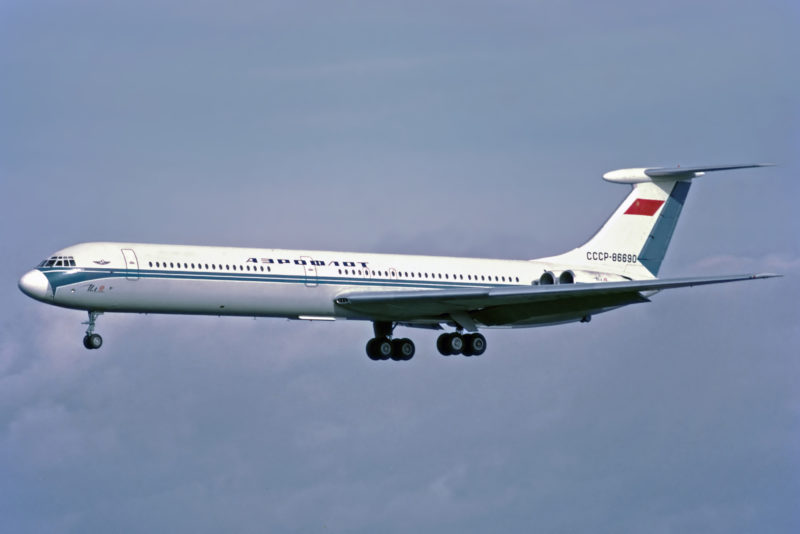
CCCP-86661 was the first production aircraft to be fully civilianised, with the anti-spin parachute in the tail replaced by a TA-6 auxiliary power unit, and was delivered to Aeroflot’s base at Krasnoyarsk in Siberia. The first revenue flight was performed on September 8, 1967 on the trunk route from Moscow to the Kazakh republic’s capital city of Alma Ata (today Almaty). The following week saw the Il-62 make its international debut, displacing the Tu-114 propliner from the transatlantic route to Montreal. The triumph and tragedy of the four-year test programme had paid off.
The first export customer for the Il-62 was Czechoslovakia’s flag carrier CSA, who got their first machine, OK-YBA, on October 29, 1969, followed by -YBB on November 28 for services to Moscow and a long-haul service to Jakarta via Damascus, Karachi and Rangoon (today Yangon). (As a star pupil of the Warsaw Pact airlines, CSA had been the first airline after Aeroflot to fly the Tu-104, and was even in the frame to operate the supersonic Tu-144 in the late 1970s.)
East Germany’s national carrier Interflug was next, DM-SEA arriving at Berlin Schonefeld on Lenin’s 100th birthday, April 22, 1970 to begin service to Moscow, followed by the Middle East — Cairo, Baghdad, Damascus, and later as far afield as Dubai, Tashkent, Havana, Hanoi, Lagos, Luanda, Karachi, Maputo and Singapore, as well as intra-European sectors such as Amsterdam, Prague, Athens and Paris.
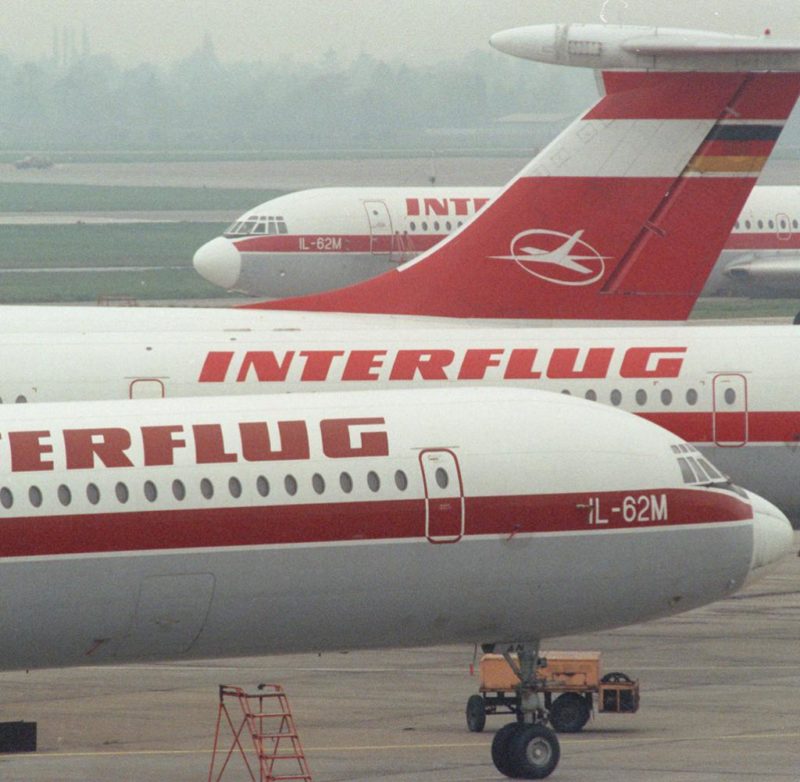
Further export customers included the CAAC (Civil Aviation Administration Of China) and United Arab Airlines / Egyptair in 1971, TAROM of Romania and Cubana in 1972, and LOT Polish Airlines in 1973. Air France and Japan Air Lines both wet-leased Il-62s from Aeroflot for service to Russia and Japan, carrying dual titles in the Aeroflot livery. Mostly they were used on long haul trips – LOT put theirs straight into transatlantic service from Warsaw to New York, Toronto and Chicago serving the large Polish populations there, while TAROM initially used theirs on shorter trips but made it across the Atlantic in the end, to New York and Chicago, with a tech stop in Amsterdam.
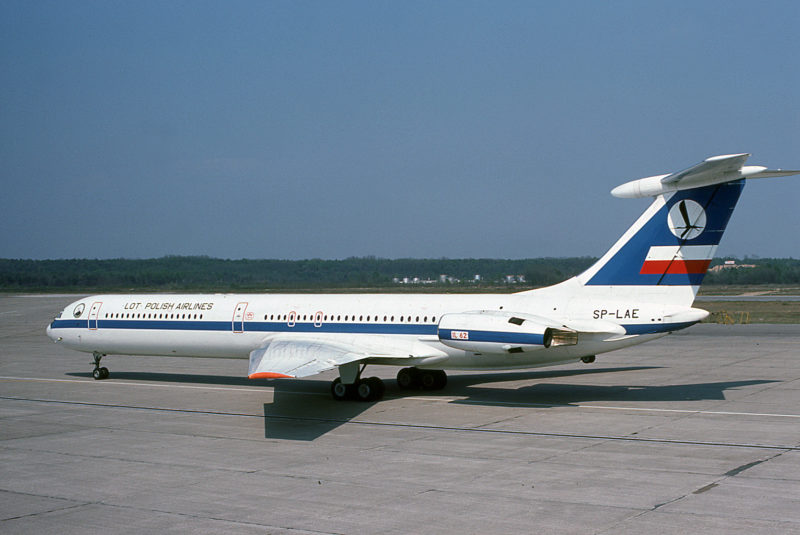
A suggested modification to improve range was designated the Il-62D (D for Dahl’niy — “long range” in Russian), which involved using the rear of the main deck for additional fuel tanks; Sergei Ilyushin felt this was not ideal for either safety or efficiency, and instead worked towards the Il-62M (M for modifitseerovannyy — “modified”), the most important upgrade being the use of Solviev D-30 engines, which were turbofans with a higher bypass ratio than the NK-8, a better engine nacelle, lower exterior noise, and a new clamshell reverse thrust bracket.
Other upgrades were the addition of a 5,000 litre tank in the tail fin, asymmetric spoiler control to assist the ailerons in roll, refined elevators for better pitch control, an upgraded APU, better cockpit lighting, new control yokes and ICAO category II-compliant avionics.
After 94 standard Il-62s were delivered, production switched to the Il-62M, the first example, CCCP-86656, getting into the air on April 15, 1972. Test flying was extensive and even included a trip to South America to evaluate the aircraft’s performance at “hot and high” airfields. The certification process was complete by November 1973 and the first revenue service with Aeroflot took place on January 8, 1974.
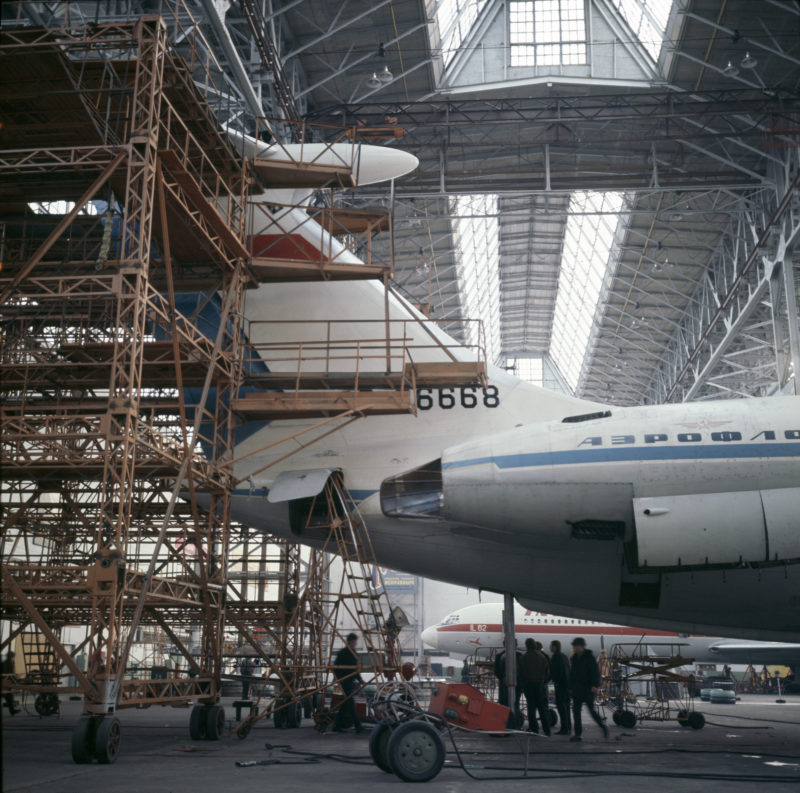
All of the airlines who operated the original Il-62 took the M version, mostly in a one-for-one fleet upgrade. Three new export customers were found — TAAG Angola (two aircraft were delivered, D2-TIF and -TIG), DETA Mozambique (one aircraft, registered C9-BAE), and Choson Minhang (today Air Koryo) of North Korea, who took four passenger liners and a head of state Salon aircraft.
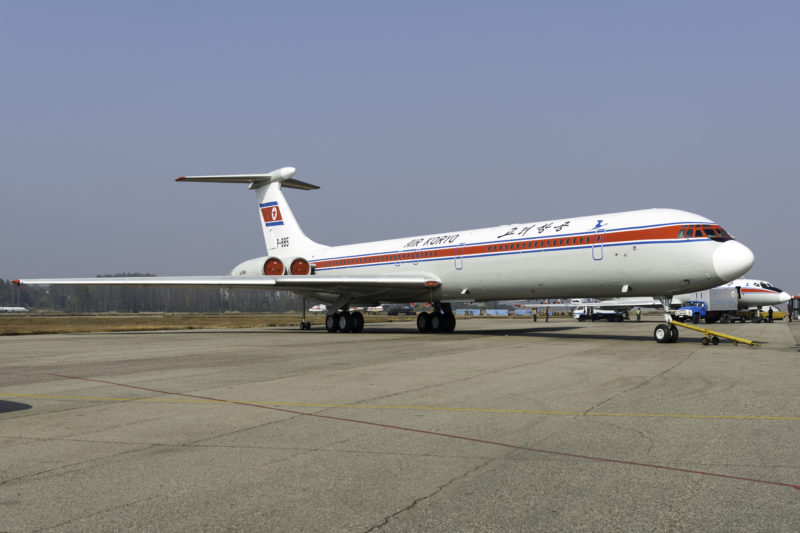
After the success of the Il-62M, a few further variants were produced in very small numbers, such as the Il-62MK, a shorter range version intended for high frequency short range operations (sixteen for Aeroflot and two for Interflug); and the Il-62MU, a combi (just one, RA-86586, operated by the Kazan factory’s own airline, KAPO Avia). The Il-62M-250 was a stretched variant, boasting an extra 22 feet and 3 inches (6.8 metres), but never left the drawing board.
While the Il-62 had an excellent safety record, with only a handful of fatal accidents, LOT Polish Airlines’ experience was noteworthy for the loss of two aircraft in identical accidents at Warsaw, seven years apart. LO 007, operated by SP-LAA, the first Il-62 delivered to the airline, was landing after an overnight flight from New York on the morning of March 14, 1980, when it initiated a go-around due to a landing gear warning light. Upon the application of full power, engine number two engine exploded, cuting control lines to the tail and causing an immediate uncontrollable descent into the ground just outside the airport perimeter with the loss of all 87 on board.
In an eery repetition, on May 9, 1987, SP-LBG, a Il-62M, was operating LO 5055 to New York; climbing hard to comply with an air traffic control instruction to avoid a block of military airspace in its path, number two engine exploded, taking out engine number one and all of the flight controls except pitch trim, and starting a fire in the rear cargo hold. Remarkably, the crew were able to keep the disabled machine in the air for thirty-one minutes and nearly made it back to the runway at Warsaw, but in the end the ship was unflyable and crashed at the opposite end of the airport of the 1980 tragedy, taking with it a further 183 lives.
In the wake of the second accident, LOT pioneered some safety upgrades to the Il-62, including duplication of flight control systems, replacing flammable elements in the cargo hold, installation of smoke detectors, and upgraded engine vibration detection systems and fire detection systems.
While 1989 itself was bad, with two major crashes (Interflug due to pilot error and Cubana due to windshear), the two decades that followed, which were the years with the most Il-62s flying, were notable for seeing no fatal accidents. Compared to the 707, VC10 and DC-8, the Il-62 had the lowest incidence of accidents, with twenty-two fatal accidents and a further eleven aircraft written off without fatalities.
Although the country that created the Il-62, the Soviet Union, had ceased to exist, the 1990s were in many ways the Il-62’s halcyon era, as the deregulation of the Russian airline scene saw the splintering of an industry that was up to that point sedate and top heavy into new flag carriers as the former Soviet republics became independent nations. What had previously been Aeroflot’s Uzbek base at Tashkent became Uzbekistan Airlines, inheriting a fleet of four Il-62 and eleven Il-62Ms to begin serving cities as far afield as London and Seoul. Air Ukraine, previously Aeroflot’s Kiev operation, sprang to life with seven Il-62Ms and opened up transatlantic flights to New York and Toronto in one direction, Bangkok in the other.
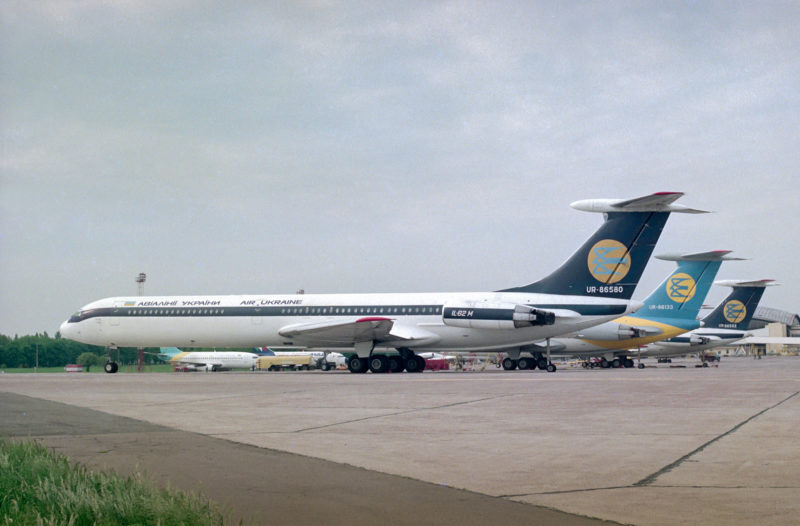
In the Russian domestic scene, new independent airlines multiplied — Interavia, Aviaenergo, Dalavia, SAT, and VIM all flew large fleets of the Il-62 in the 1990s. Forty-five machines passed through the hands of Domodedovo Airlines alone. At most of these airlines, the ageing Il-62s were flown hard enough to peel the paint off — some averaged seventeen hours of use per day. In the Czech Republic, ex-CSA machines were snapped up cheaply by budding airline moguls to create Espe Air Prague, Egret BMI and Bemoair.
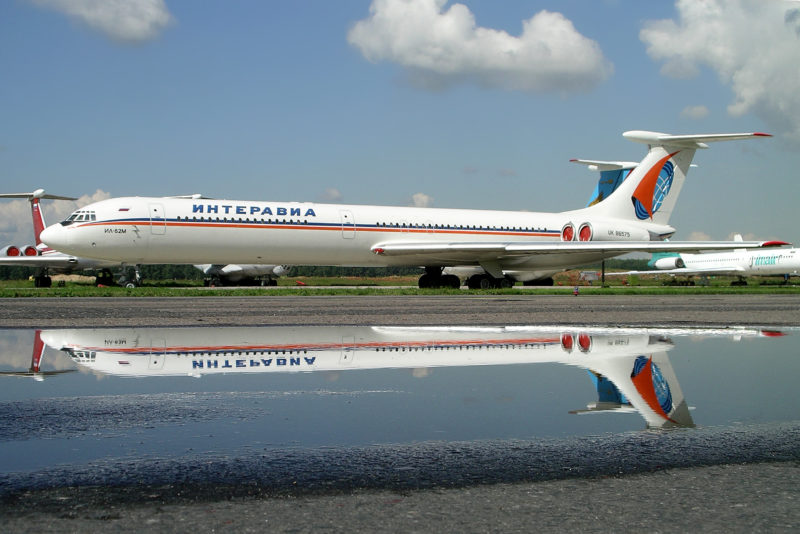
Aeroflot itself, while a fraction of it’s former size, was able to benefit from the reduction in political tension — the peace dividend – in the world, and catered to an increase in international flying. New routes were added including Moscow-Larnaca-Sal-Rio-Sao Paolo, and Moscow-Shannon-Havana-Panama-Managua. In fact the Il-62M fleet was doing so much transatlantic flying that on certain days of the week, eight aircraft were dropping into Shannon for refuelling in the space of a few hours — each way.
An interesting aside to the Il-62 and Aeroflot’s story with Shannon: starting in the 1980s, Aeroflot (after complaining of high fuel prices at Shannon and moving some of their stopover traffic to Gander in Canada) came to an arrangement with the handling agent at Shannon that the Soviet Union, and later Russia, could build their own fuel farm and deliver their own fuel to the airport. This fuel was supplied by the Soviet, and later Russian, government. By the mid 1980s, 3,000 Aeroflot movements a year were being fueled, with regular deliveries of 1.25 million gallons of top quality Jet A-1 at a time on tankers from the Black Sea. For Aeroflot, the pleasing collateral benefit of this arrangement was that as the fuel came from their government, it somehow didn’t show up on Aeroflot’s financials. So the story goes, Aer Rianta then offered Aeroflot free landing fees and ground handling services (parking, steps, ground power, line maintenance etc) in return for the ability to sell off some of this magic free fuel to other airlines just a little less than at market rate. This made the airport a popular stopover and attracted TWA, Rich International, American Trans Air, Worldways and TAROM on their way to and from the Atlantic. Hey, get a little, give a little.
As the 1990s rolled into the 2000s, the availability of middle-aged Boeing and Airbus jets with comparable seating capacity but far superior economics finally spelled out a gradual end for the Il-62 and other Soviet-era hardware. Aeroflot’s last thirteen Il-62s were stood down on November 1, 2001. Other Russian carriers followed suit as the decade wore on. A common sight in provincial Russian airports for a while was old Ilyushins and Tupolevs parked around the fringes of the fields, streaked with mildew, birds nests in engine cowlings. Today most have been scrapped.
The final production Il-62 was built in 1995 without a delivery customer and put into storage. KAPO, the Kazan Aircraft Production Association, the latter-day owner of Aircraft Factory Number 22, formed KAPO Avia in 1999 and put RA-86586 into service themselves, flying charter trips or leases on behalf of some of the world’s most obscure airlines — Magma Airlines, BGB Air, Luk Aero — before it was acquired by Kazakh broker Sayat Air and reregistered as UP-i6205.
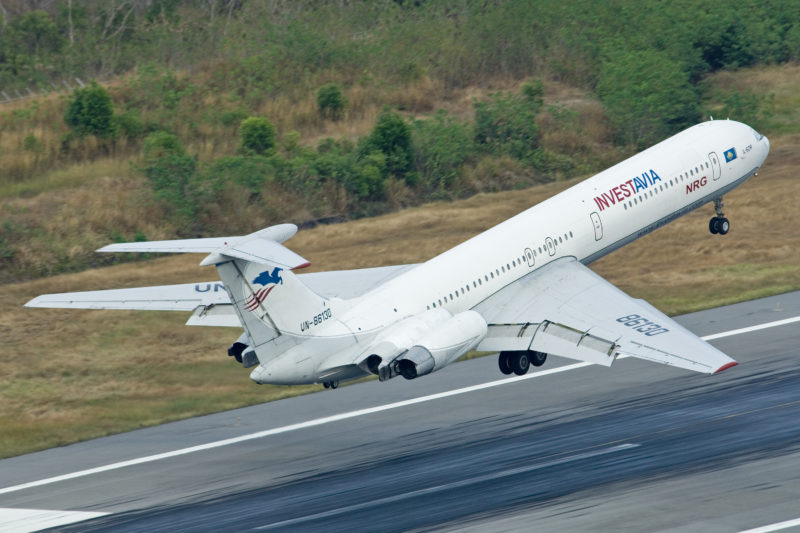
The rock-bottom price and long range of the Il-62M, many of which were still available with low airframe hours, and with plenty of old boys who knew how to fly them still around, whose more adaptable, English-speaking erstwhile colleages had gone off and by hook or by crook got themselves A320 and 737 typeratings and jobs with the emergent national carrier, were quite happy to drag their old Aeroflot uniform out of the closet in Almaty or Osh and go and fly Il-62s in Iran, Sudan or Equatorial Guinea.
Iran in particular represented rich pickings for airliners with pilots for hire, as documented in more detail in the chapter about the Tupolev Tu-154, as the country, geographically vast and with a huge and growing population, was restricted from buying new planes due to a diplomatic falling-out with the United States. Kazakh-sourced and –crewed Il-62s came in towards the tail end of the peroid that this capacity gap was filled with Soviet hardware, but alas sister ship UP-i6208, an older ship delivered to Interflug in 1989, crashed on landing in Mashhad on July 24, which brought Aria Air’s experiment to a premature end. For fans of the Il-62 this is a lost alternate future – Aria had big plans for the Il-62, with a fourth Il-62, UP-i6210, arriving from Kazakhstan to Tehran just eight days before the crash in the partial livery of previous operator InvestAvia, never to enter service with Aria Air. Expansion was not only planned to a wider Iranian domestic network, but international flights to Kuwait, Moscow, Istanbul, and Bombay, with more Il-62s to come. UP-i6205’s ferry flight to Fujairah in 2014 will almost certainly be its last, with only a thousand hours at most in the logbook — such is the price of being born too late.
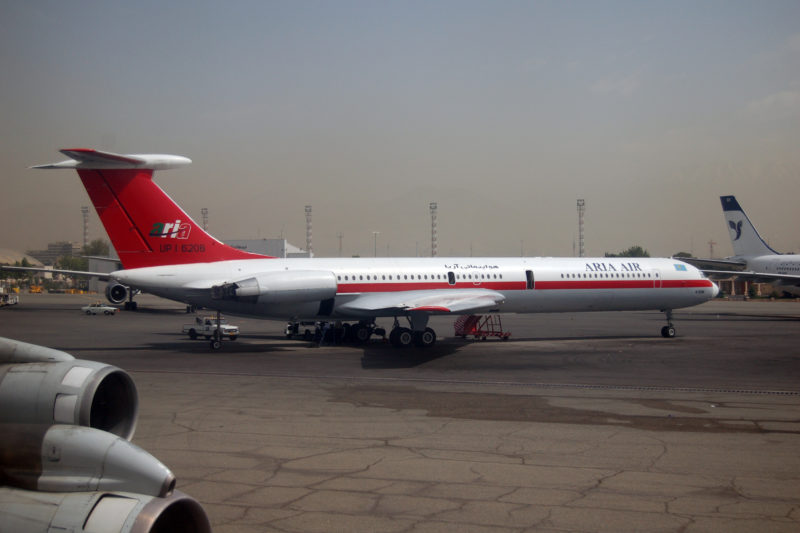
Cubana was one of the last major airlines to fly the Il-62, with transatlantic flights (to Madrid, Paris, Frankfurt and Las Palmas) and routes throughout Latin and South America gradually being reduced to neighbouring Santo Domingo, Mexico City, Recife and Caracas. The last aircraft, CU-T1284, was stood down on March 1, 2011.
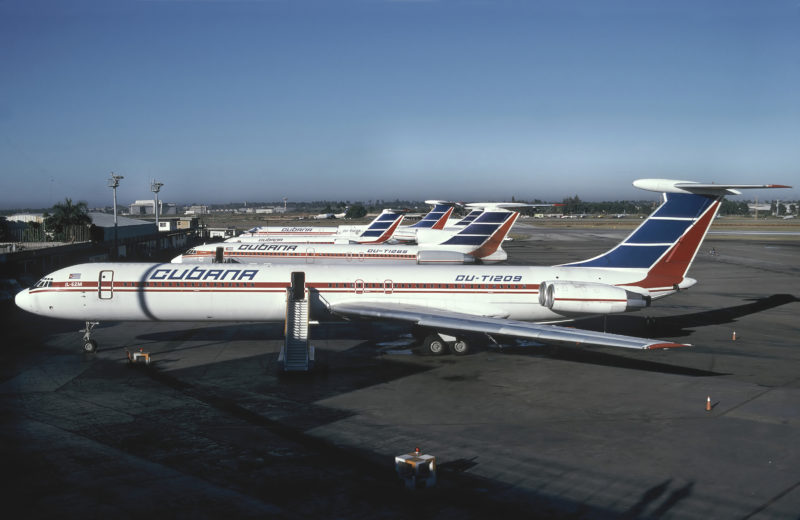
The following year, North Korea’s flag carrier Air Koryo bought CU-T1280, reregistered it P-886P and in July 2012 flew it from Havana to Pyongyang where it was scrapped for parts to support North Korea’s surviving pair of passenger machines (P-881 and P-885) plus Kim Jong Un’s head of state aircraft (‘Air Force Un’). Having once flown as far afield as Moscow, Berlin, Sofia and Belgrade in the halcyon days of the 1980s, by 2012 Air Koryo mainly flew the Il-62 on the trunk route to Beijing, with occasional appearances at Shenyang, Moscow, Bangkok and Macau. On the last day of 2012, China banned the type due to noise; P-881 went to the air force as a back-up for Air Force Un, leaving P-885, North Korea’s first Il-62M (delivered in 1979), to remain in service.

Even in a country with a tiny geographical footprint, an economy operating (at least on face value) at a very low level, a population unable to travel, and the type banned on the main international trunk route (Beijing), there is still room for P-885 to make a living in North Korea, as uplift is occasionally needed on ad hoc domestic runs (such as to transport a delegation to Mount Pektu, or a workers charter between Pyongyang and the country’s second biggest city, the industrial hub of Hamhung). Air Koryo’s once-a-week flight to Vladivostok, when demand outstrips the supply of seats on the usual Il-18, is subbed with the Il-62, which has no environmental restrictions against it in Russia. Don’t dream it’s over.
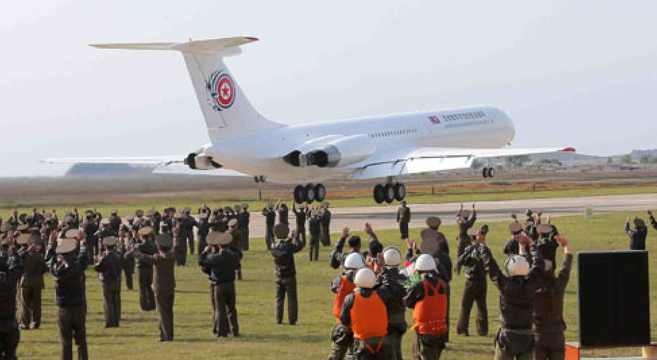
One more Il-62 was built, over a whole decade later — on October 8, 2009, RA-86495 was completed using parts at Kazan for the Russian government. Oddly, it was given the same manufacturer’s serial number and registration as a 1977-build Il-62MK that flew for Aeroflot and the Soviet military and later with Moscow Airlines; that original machine was damaged beyond repair in 2002 and scrapped at Chkalovsky. The second incarnation of RA-86495 remains in service to this day with the Russian Air Force’s 223rd Flight Unit which specialises in transport and logistics up to and including head of state transportation.
Comparison to the VC-10 is inevitable given the similar appearance of the two aircraft, and western chauvinism insists that the Vickers machine must be superior to the “VC-10ski”, but while the VC-10 had inferior range and only 54 were produced, Russia’s first long range jet was a success by any standard — 295 produced between 1963 and 1995 (plus 2009’s one-off), flying for countless airlines in over thirty nations including 213 passing through the fleet of Aeroflot. Today the Il-62 remains in service with one airline (North Korea’s Air Koryo) and a number of governments including Sudan, Russia, The Gambia and Ukraine. Of all the aircraft designed by Sergei Ilyushin, it is the silhouette of an Il-62 that is carved into his headstone as his greatest achievement — the flagship of the Russia’s Soviet era.
Sam’s Travel Hacks

As a frequent flier, I recommend book flights and compare prices on Skyscanner and JustFly for the best deals on the internet. We have put together many useful travel tips and airfare promotions in my Smart Travel section to guide you travel in more luxury with lower price!
Flying soviet era coffin. Hundreds people died in crashes around the world. Shame to even mention that thing as airplane.
Maybe you haven’t read the article: “Compared to the 707, VC10 and DC-8, the Il-62 had the lowest incidence of accidents, with twenty-two fatal accidents and a further eleven aircraft written off without fatalities”.
Silly much? You obviously living on another planet.
Great article Sam! There is a story connected with the two LOT crashes that reminds me Final Destination film. The Mechanic Ryszard Chmielewski, who couldn’t fly on LO 007 flight due to some health issues and was replaced by a colleague, died onboard the plane performing LO 5055 flight, on which he was Instructor. Best regards
Wonderful article Sam! I had a chance to fly on a few. Great memories.
Please start praying for people who died on those flying coffins.
Leave a Reply Cancel reply
Your email address will not be published. Required fields are marked *
Notify me of follow-up comments by email.
Notify me of new posts by email.
This site uses Akismet to reduce spam. Learn how your comment data is processed .
Columbia University in the City of New York
Miriam and ira d. wallach art gallery.
- Visitor Information
- Exhibitions
- Publications
Moscow: City, Spectacle, Capital of Photography
April 30–june 21, 2003.
Moscow: City, Spectacle, Capital of Photography , an exhibition of 20th-century photographs of Moscow, opens at Columbia University's Miriam and Ira D. Wallach Art Gallery on Wednesday, April 30, 2003 and remains on display through Saturday, June 21, 2003.
Moscow has been a powerful magnet for many Russian photographers of the 20th century. Moscow: City, Spectacle, Capital of Photography presents the work of 31 photographers, whose images have defined the visual experience of Moscow from the 1920s to the present. Diverse in form and strategy, the 90 photographs chosen for the exhibition trace the history of Russian documentary photography and offer insight into individual practices. From Aleksandr Rodchenko's constructivist visions and Evgenii Khaldei's humanist landscapes to Igor Moukhin's scenes of urban spectacle and alienation in the works of Russia's key 20th-century photographers, Moscow ventures beyond the expected image as a site of famous landmarks, architectural treasures and dramatic lifestyles.
Early 20th-century photographers Boris Ignatovich and Arkadii Shaikhet saw themselves in the vanguard of an emerging mass-media culture, defining with their cameras the visual experience of Soviet modernity. For nearly 70 years, Soviet photography was assigned the duty of maintaining the ideological rigidity of the Soviet State. Yet, as examples of the work of Iakov Khalip, Anatolii Egorov, Mikhail Savin, and Mark Markov-Grinberg show, Soviet photographic practices were much more complex than has been previously acknowledged. The works of these photographers remain intensely compelling to a modernist eye.
Contemporary Russian photographers, such as Lev Melikhov, Valerii Stigneev and Sergei Leontiev, engage with the legacy of the Soviet documentary photography. But for them the documentary is a complex and multivalent genre, which incorporates subjectivity, ambiguity and reflexivity and comments on social and cultural issues without losing sight of the position from which that commentary is made. In the recent photographs by Vladimir Kupriyanov, Igor Moukhin, Anna Gorunova and Pakito Infante, the "real" space of Moscow is replaced by an imaginary and optical spaces of virtuality.
The works in the exhibition are on loan from Moscow's Cultural Center Dom, and many are being shown outside Russia for the first time. In conjunction with the exhibition, the Wallach Art Gallery is publishing an illustrated catalogue with a scholarly essay by the exhibition curator, Nadia Michoustina, a Ph.D. candidate in Columbia University's Department of Slavic Languages. The essay presents a nuanced history of Russian photography of the 20th century, and contributes to an interpretation of extraordinary images.
Receive great stories from around the world directly in your inbox.
Stay up to date about Global Voices and our mission. See our Privacy Policy for details. Newsletter powered by Mailchimp ( Privacy Policy and Terms ).
- bahasa Indonesia
See all those languages up there? We translate Global Voices stories to make the world's citizen media available to everyone.
- What Is Global Voices?
- Partner with Global Voices
- Translation Services
- Arts & Culture
- Breaking News
- Citizen Media
- Development
- Digital Activism
- Economics & Business
- Environment
- Ethnicity & Race
- Freedom of Speech
- Human Rights
- Humanitarian Response
- International Relations
- Media & Journalism
- Migration & Immigration
- Photography
- War & Conflict
- Women & Gender
Moscow's Top Cancer Hospital Under Pressure Amidst Drive for Health Care Privatization
Translations

Moscow City Oncology Hospital No. 62. Source: http://onco62.ru/history/.
On November 8, Moscow Mayor Sergey Sobyanin signed an order into law stripping Moscow City Oncological Hospital No. 62, one of Russia's most well-regarded cancer hospitals, of its status as an autonomous institution. In the technocratic parlance of Moscow city officials, the hospital had been “optimized,” coming under the budgetary purview of the city government, and ostensibly improving the institution's efficiency.
But to many, the reclassification of Hospital No. 62 seemed less like an optimization than a step towards closure —part of a broader movement towards the privatization of the Russian health care system, which is supposed to provide free health services to the country’s 140 million citizens. Indeed, less than three weeks after Sobyanin signed the order, the hospital's chief physician resigned and doctors began wondering about their institution's future. With private hospitals replacing public hospitals around Moscow, and with remaining public hospitals becoming increasingly overburdened and underfunded, many question how long the existing system can hold out.

Support our work
Global Voices stands out as one of the earliest and strongest examples of how media committed to building community and defending human rights can positively influence how people experience events happening beyond their own communities and national borders.
Please consider making a donation to help us continue this work.
Recent Russia Stories

How the North Caucasus became one of Russia’s arms for imperial policy in Ukraine

Lotteries, dressed-up figures, and other peculiar entertainment at the Putin's sham elections

New song titled ‘Mom has a Secret’ features mothers from Russia who are anti-war activists
Top world stories.

Women march for Palestine and against patriarchy in Pakistan

US-funded news outlet Radio Free Asia to withdraw from Hong Kong

‘Jumbo,’ Trinidad & Tobago's treasured ‘Nuts Man,’ leaves lessons of patriotism
[…] by Isaac Webb · comments (0) Donate · Share this: twitter facebook reddit […]
Join the conversation
Authors, please log in »
Name (required)
Email (will not be published) (required)
Subscribe to comments on this post via email
- All comments are reviewed by a moderator . Do not submit your comment more than once or it may be identified as spam.
- Please treat others with respect . Comments containing hate speech, obscenity, and personal attacks will not be approved.
Global Voices is supported by the efforts of our volunteer contributors, foundations, donors and mission-related services. For more information please read our Fundraising Ethics Policy .
Special thanks to our many sponsors and funders .
Please support our important work:
-->